door lock CHEVROLET CAVALIER 2004 3.G Owners Manual
[x] Cancel search | Manufacturer: CHEVROLET, Model Year: 2004, Model line: CAVALIER, Model: CHEVROLET CAVALIER 2004 3.GPages: 354, PDF Size: 2.42 MB
Page 1 of 354
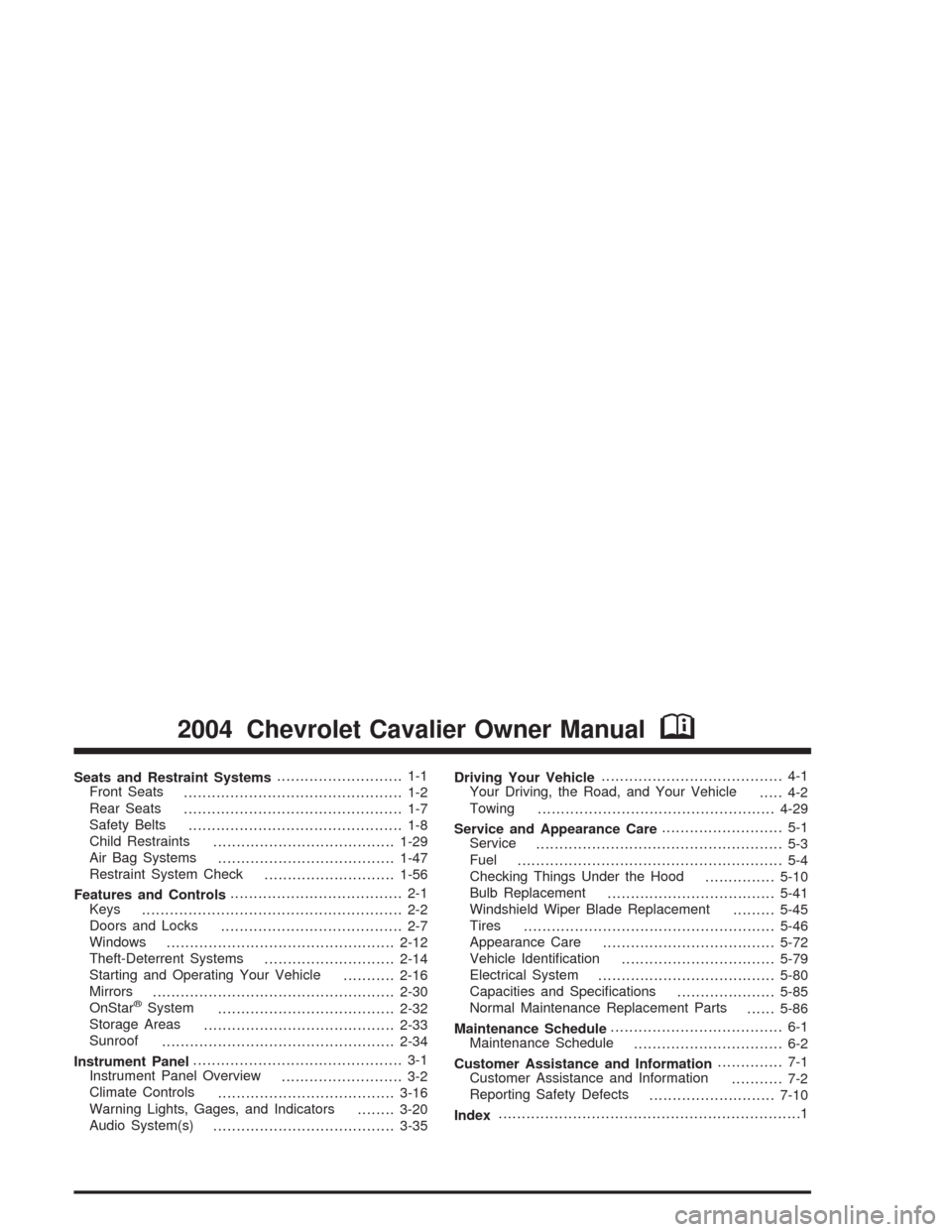
Seats and Restraint Systems........................... 1-1
Front Seats
............................................... 1-2
Rear Seats
............................................... 1-7
Safety Belts
.............................................. 1-8
Child Restraints
.......................................1-29
Air Bag Systems
......................................1-47
Restraint System Check
............................1-56
Features and Controls..................................... 2-1
Keys
........................................................ 2-2
Doors and Locks
....................................... 2-7
Windows
.................................................2-12
Theft-Deterrent Systems
............................2-14
Starting and Operating Your Vehicle
...........2-16
Mirrors
....................................................2-30
OnStar
®System
......................................2-32
Storage Areas
.........................................2-33
Sunroof
..................................................2-34
Instrument Panel............................................. 3-1
Instrument Panel Overview
.......................... 3-2
Climate Controls
......................................3-16
Warning Lights, Gages, and Indicators
........3-20
Audio System(s)
.......................................3-35Driving Your Vehicle....................................... 4-1
Your Driving, the Road, and Your Vehicle
..... 4-2
Towing
...................................................4-29
Service and Appearance Care.......................... 5-1
Service
..................................................... 5-3
Fuel
......................................................... 5-4
Checking Things Under the Hood
...............5-10
Bulb Replacement
....................................5-41
Windshield Wiper Blade Replacement
.........5-45
Tires
......................................................5-46
Appearance Care
.....................................5-72
Vehicle Identi�cation
.................................5-79
Electrical System
......................................5-80
Capacities and Speci�cations
.....................5-85
Normal Maintenance Replacement Parts
......5-86
Maintenance Schedule..................................... 6-1
Maintenance Schedule
................................ 6-2
Customer Assistance and Information.............. 7-1
Customer Assistance and Information
........... 7-2
Reporting Safety Defects
...........................7-10
Index.................................................................1
2004 Chevrolet Cavalier Owner ManualM
Page 12 of 354
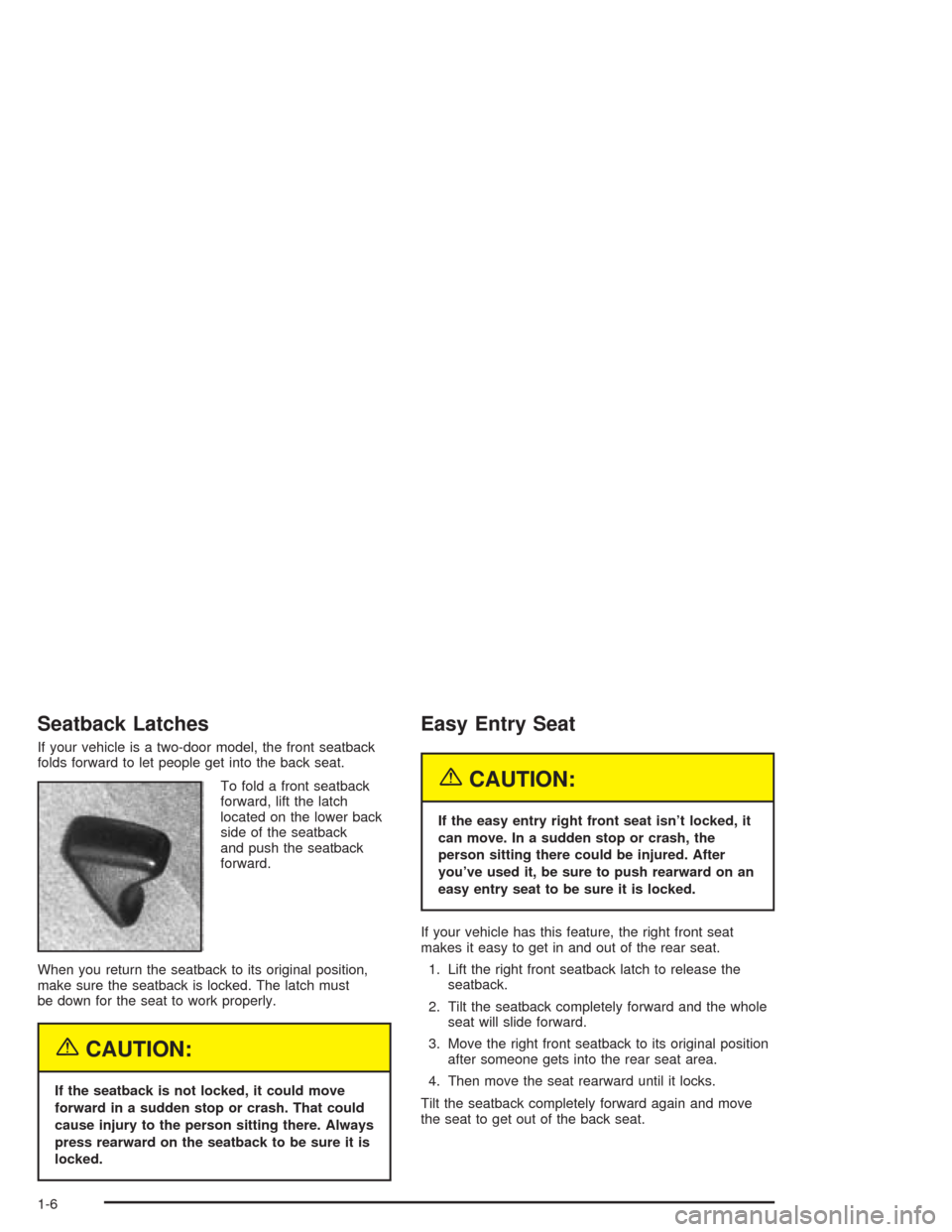
Seatback Latches
If your vehicle is a two-door model, the front seatback
folds forward to let people get into the back seat.
To fold a front seatback
forward, lift the latch
located on the lower back
side of the seatback
and push the seatback
forward.
When you return the seatback to its original position,
make sure the seatback is locked. The latch must
be down for the seat to work properly.
{CAUTION:
If the seatback is not locked, it could move
forward in a sudden stop or crash. That could
cause injury to the person sitting there. Always
press rearward on the seatback to be sure it is
locked.
Easy Entry Seat
{CAUTION:
If the easy entry right front seat isn’t locked, it
can move. In a sudden stop or crash, the
person sitting there could be injured. After
you’ve used it, be sure to push rearward on an
easy entry seat to be sure it is locked.
If your vehicle has this feature, the right front seat
makes it easy to get in and out of the rear seat.
1. Lift the right front seatback latch to release the
seatback.
2. Tilt the seatback completely forward and the whole
seat will slide forward.
3. Move the right front seatback to its original position
after someone gets into the rear seat area.
4. Then move the seat rearward until it locks.
Tilt the seatback completely forward again and move
the seat to get out of the back seat.
1-6
Page 20 of 354
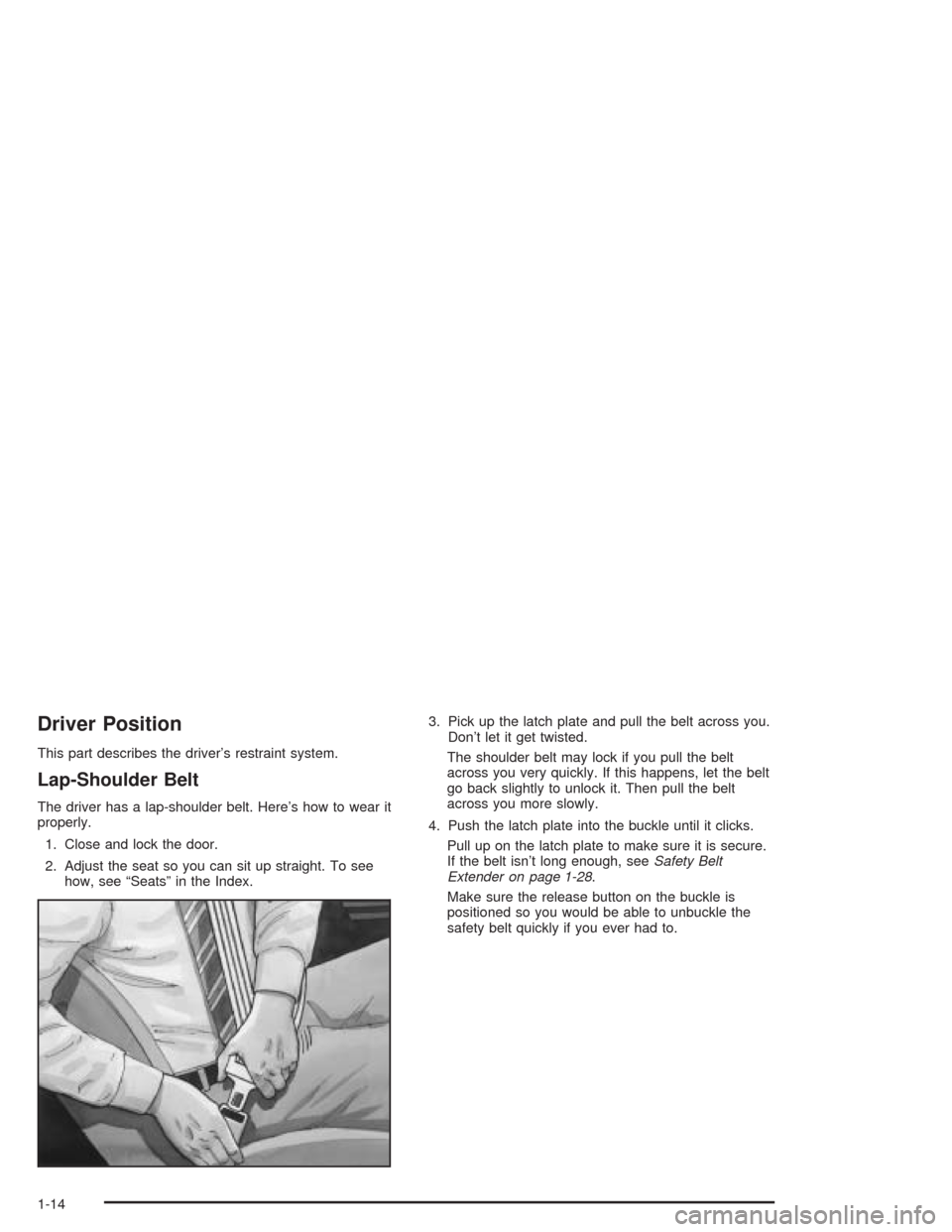
Driver Position
This part describes the driver’s restraint system.
Lap-Shoulder Belt
The driver has a lap-shoulder belt. Here’s how to wear it
properly.
1. Close and lock the door.
2. Adjust the seat so you can sit up straight. To see
how, see “Seats” in the Index.3. Pick up the latch plate and pull the belt across you.
Don’t let it get twisted.
The shoulder belt may lock if you pull the belt
across you very quickly. If this happens, let the belt
go back slightly to unlock it. Then pull the belt
across you more slowly.
4. Push the latch plate into the buckle until it clicks.
Pull up on the latch plate to make sure it is secure.
If the belt isn’t long enough, seeSafety Belt
Extender on page 1-28.
Make sure the release button on the buckle is
positioned so you would be able to unbuckle the
safety belt quickly if you ever had to.
1-14
Page 22 of 354
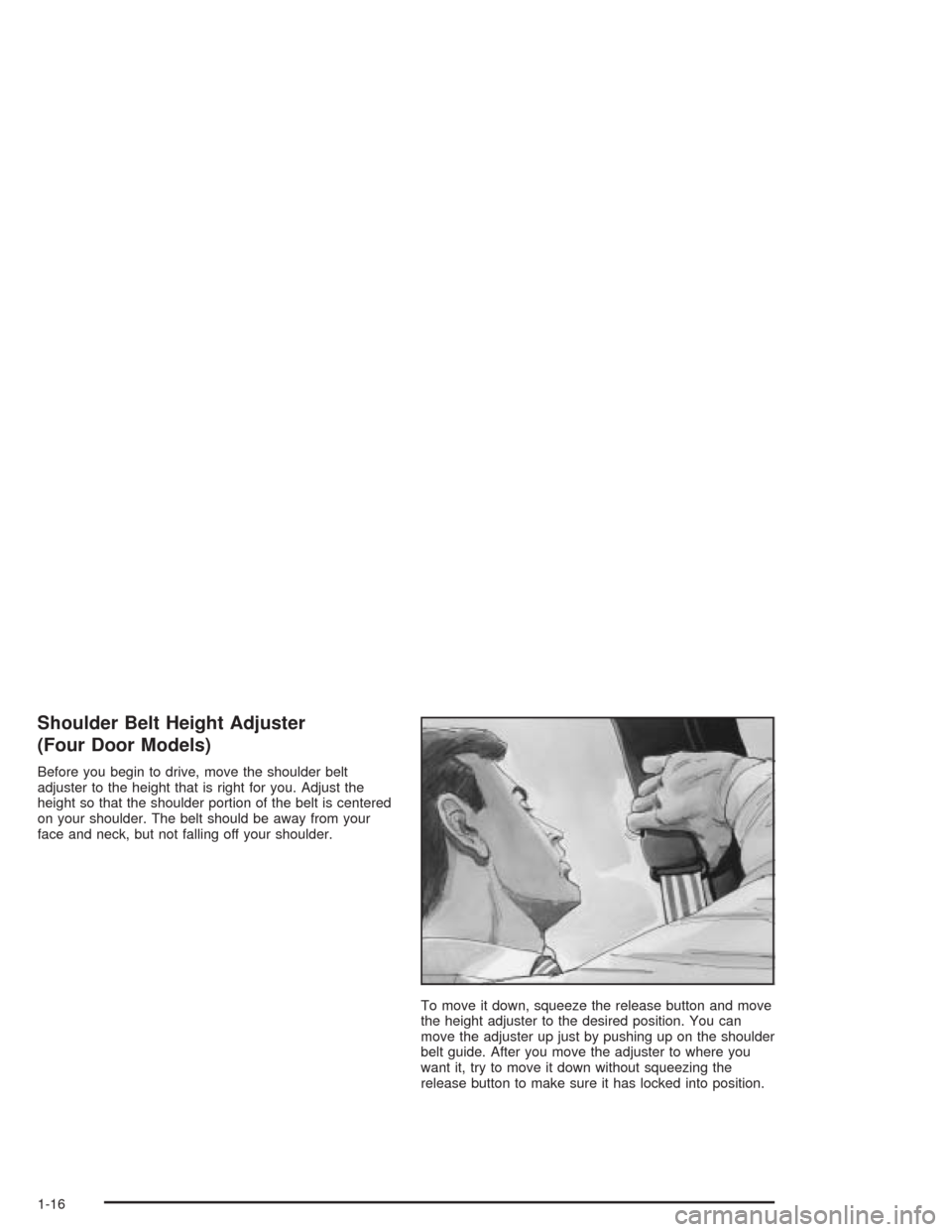
Shoulder Belt Height Adjuster
(Four Door Models)
Before you begin to drive, move the shoulder belt
adjuster to the height that is right for you. Adjust the
height so that the shoulder portion of the belt is centered
on your shoulder. The belt should be away from your
face and neck, but not falling off your shoulder.
To move it down, squeeze the release button and move
the height adjuster to the desired position. You can
move the adjuster up just by pushing up on the shoulder
belt guide. After you move the adjuster to where you
want it, try to move it down without squeezing the
release button to make sure it has locked into position.
1-16
Page 58 of 354
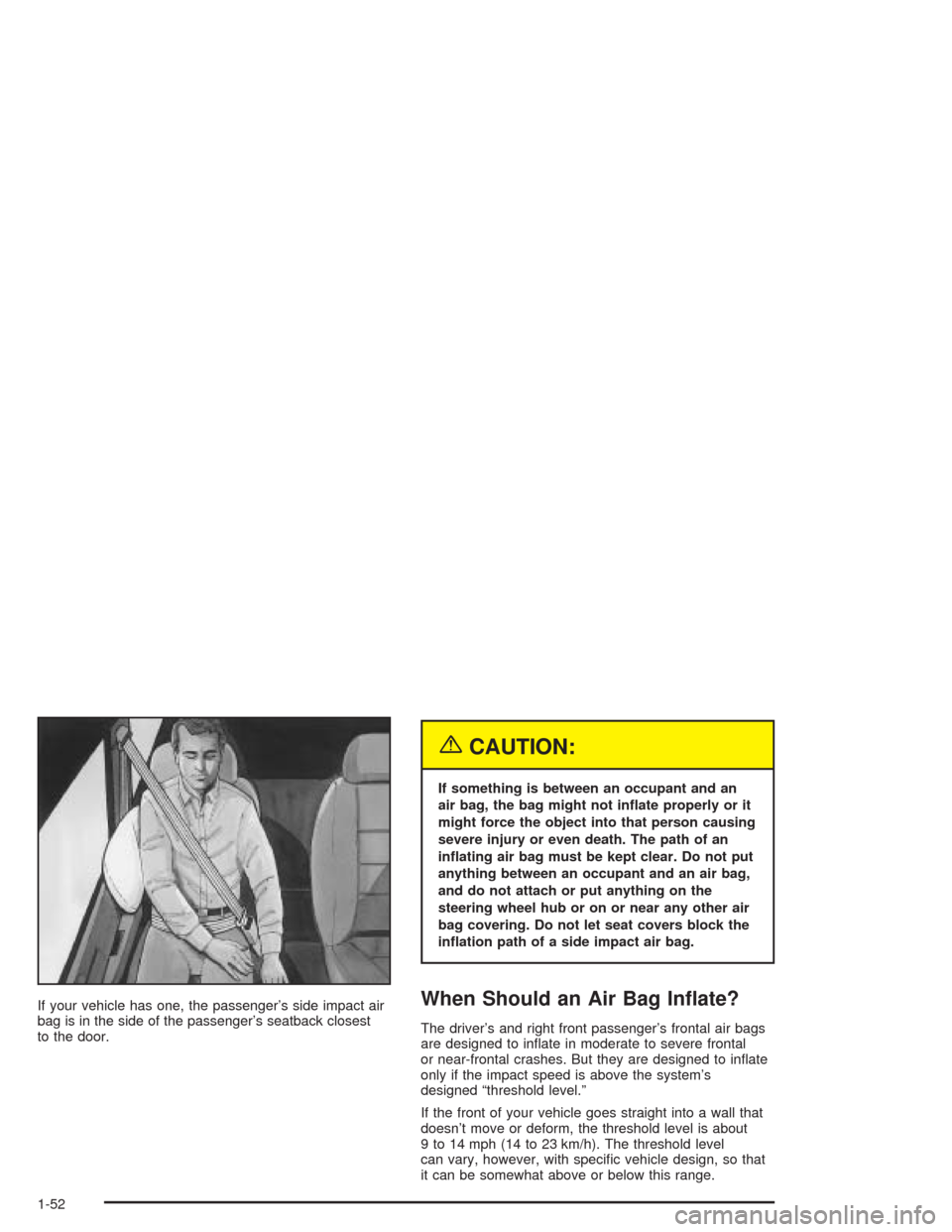
If your vehicle has one, the passenger’s side impact air
bag is in the side of the passenger’s seatback closest
to the door.
{CAUTION:
If something is between an occupant and an
air bag, the bag might not in�ate properly or it
might force the object into that person causing
severe injury or even death. The path of an
in�ating air bag must be kept clear. Do not put
anything between an occupant and an air bag,
and do not attach or put anything on the
steering wheel hub or on or near any other air
bag covering. Do not let seat covers block the
in�ation path of a side impact air bag.
When Should an Air Bag In�ate?
The driver’s and right front passenger’s frontal air bags
are designed to in�ate in moderate to severe frontal
or near-frontal crashes. But they are designed to in�ate
only if the impact speed is above the system’s
designed “threshold level.”
If the front of your vehicle goes straight into a wall that
doesn’t move or deform, the threshold level is about
9 to 14 mph (14 to 23 km/h). The threshold level
can vary, however, with speci�c vehicle design, so that
it can be somewhat above or below this range.
1-52
Page 65 of 354
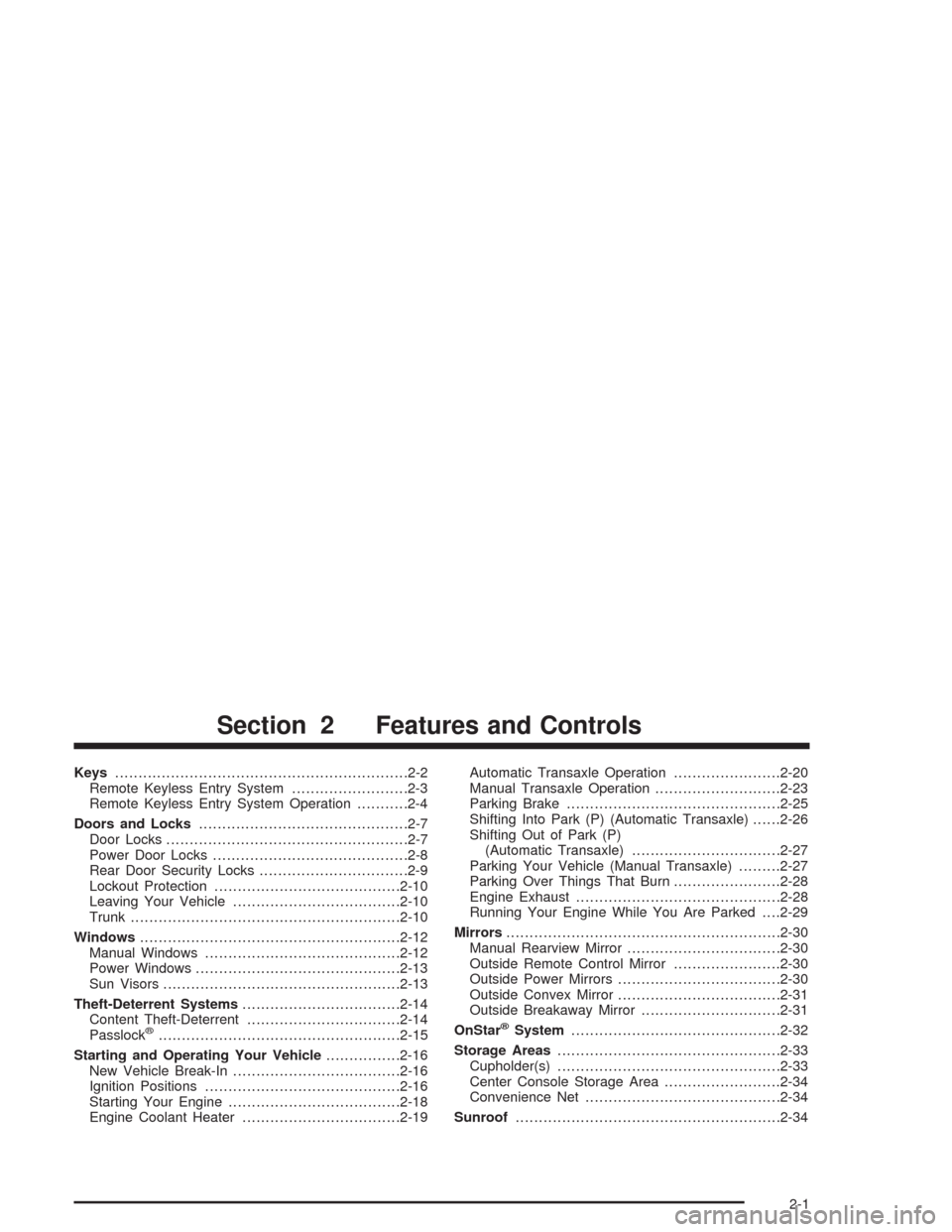
Keys...............................................................2-2
Remote Keyless Entry System.........................2-3
Remote Keyless Entry System Operation...........2-4
Doors and Locks.............................................2-7
Door Locks....................................................2-7
Power Door Locks..........................................2-8
Rear Door Security Locks................................2-9
Lockout Protection........................................2-10
Leaving Your Vehicle....................................2-10
Trunk..........................................................2-10
Windows........................................................2-12
Manual Windows..........................................2-12
Power Windows............................................2-13
Sun Visors...................................................2-13
Theft-Deterrent Systems..................................2-14
Content Theft-Deterrent.................................2-14
Passlock
®....................................................2-15
Starting and Operating Your Vehicle................2-16
New Vehicle Break-In....................................2-16
Ignition Positions..........................................2-16
Starting Your Engine.....................................2-18
Engine Coolant Heater..................................2-19Automatic Transaxle Operation.......................2-20
Manual Transaxle Operation...........................2-23
Parking Brake..............................................2-25
Shifting Into Park (P) (Automatic Transaxle)......2-26
Shifting Out of Park (P)
(Automatic Transaxle)................................2-27
Parking Your Vehicle (Manual Transaxle).........2-27
Parking Over Things That Burn.......................2-28
Engine Exhaust............................................2-28
Running Your Engine While You Are Parked. . . .2-29
Mirrors...........................................................2-30
Manual Rearview Mirror.................................2-30
Outside Remote Control Mirror.......................2-30
Outside Power Mirrors...................................2-30
Outside Convex Mirror...................................2-31
Outside Breakaway Mirror..............................2-31
OnStar®System.............................................2-32
Storage Areas................................................2-33
Cupholder(s)................................................2-33
Center Console Storage Area.........................2-34
Convenience Net..........................................2-34
Sunroof.........................................................2-34
Section 2 Features and Controls
2-1
Page 67 of 354
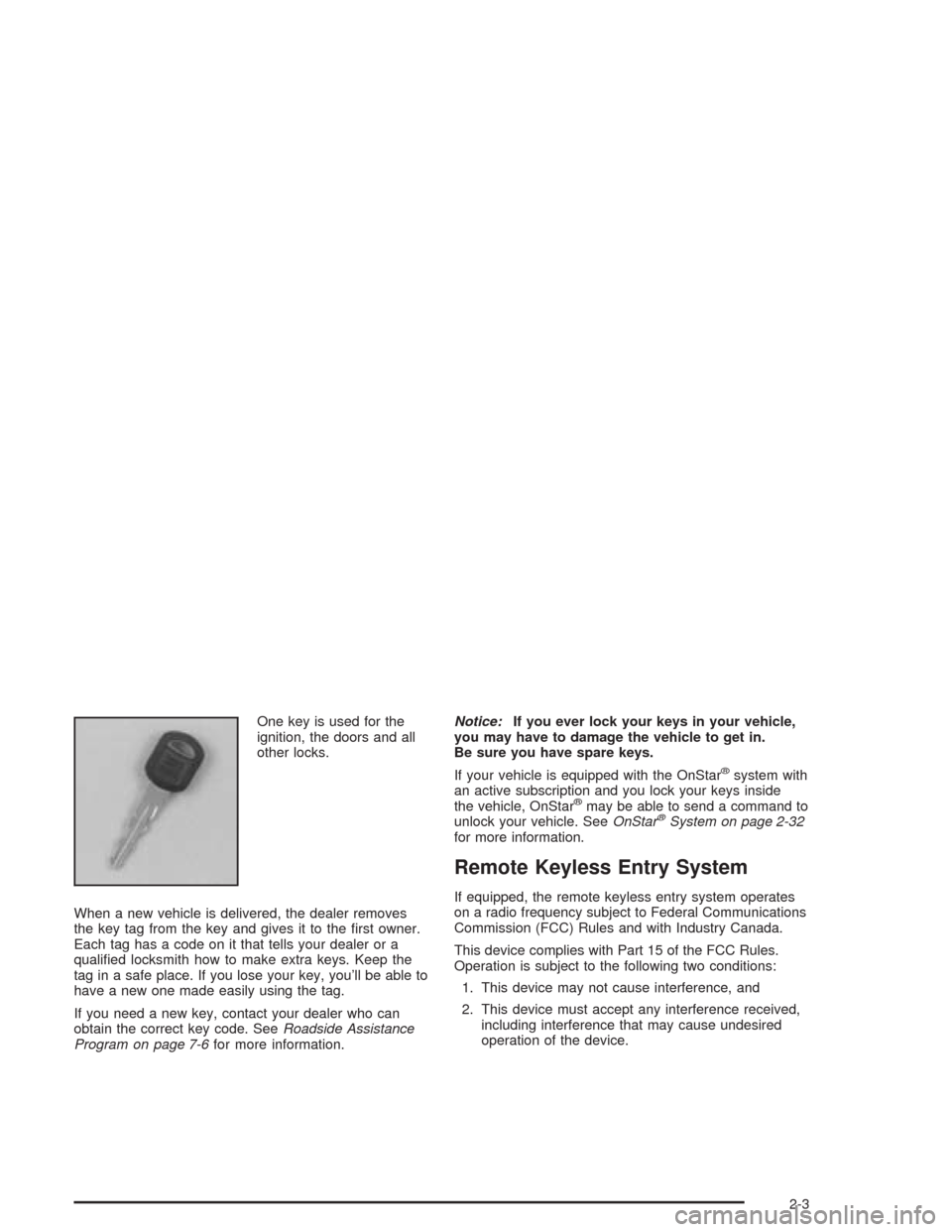
One key is used for the
ignition, the doors and all
other locks.
When a new vehicle is delivered, the dealer removes
the key tag from the key and gives it to the �rst owner.
Each tag has a code on it that tells your dealer or a
quali�ed locksmith how to make extra keys. Keep the
tag in a safe place. If you lose your key, you’ll be able to
have a new one made easily using the tag.
If you need a new key, contact your dealer who can
obtain the correct key code. SeeRoadside Assistance
Program on page 7-6for more information.Notice:If you ever lock your keys in your vehicle,
you may have to damage the vehicle to get in.
Be sure you have spare keys.
If your vehicle is equipped with the OnStar
®system with
an active subscription and you lock your keys inside
the vehicle, OnStar
®may be able to send a command to
unlock your vehicle. SeeOnStar®System on page 2-32
for more information.
Remote Keyless Entry System
If equipped, the remote keyless entry system operates
on a radio frequency subject to Federal Communications
Commission (FCC) Rules and with Industry Canada.
This device complies with Part 15 of the FCC Rules.
Operation is subject to the following two conditions:
1. This device may not cause interference, and
2. This device must accept any interference received,
including interference that may cause undesired
operation of the device.
2-3
Page 68 of 354
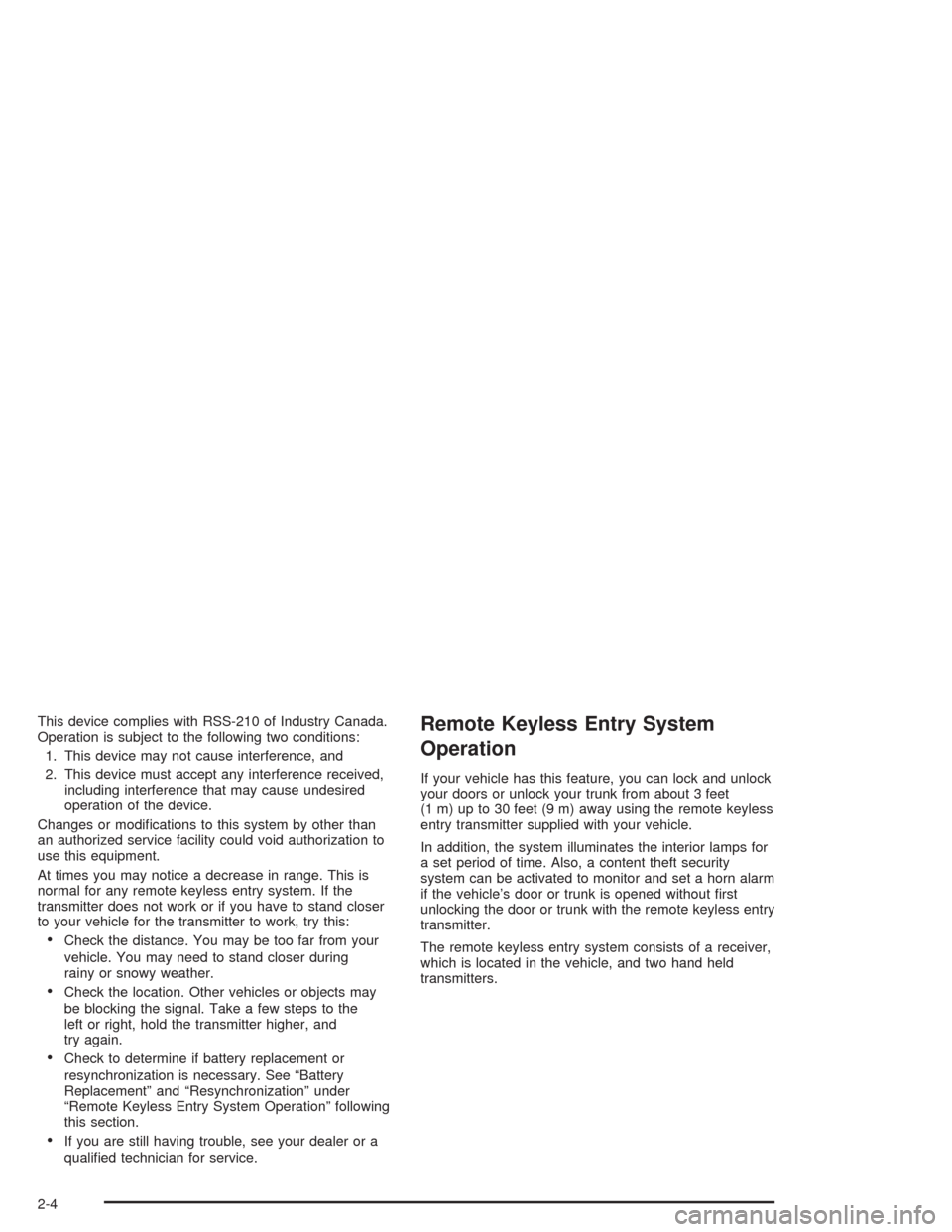
This device complies with RSS-210 of Industry Canada.
Operation is subject to the following two conditions:
1. This device may not cause interference, and
2. This device must accept any interference received,
including interference that may cause undesired
operation of the device.
Changes or modi�cations to this system by other than
an authorized service facility could void authorization to
use this equipment.
At times you may notice a decrease in range. This is
normal for any remote keyless entry system. If the
transmitter does not work or if you have to stand closer
to your vehicle for the transmitter to work, try this:
Check the distance. You may be too far from your
vehicle. You may need to stand closer during
rainy or snowy weather.
Check the location. Other vehicles or objects may
be blocking the signal. Take a few steps to the
left or right, hold the transmitter higher, and
try again.
Check to determine if battery replacement or
resynchronization is necessary. See “Battery
Replacement” and “Resynchronization” under
“Remote Keyless Entry System Operation” following
this section.
If you are still having trouble, see your dealer or a
quali�ed technician for service.
Remote Keyless Entry System
Operation
If your vehicle has this feature, you can lock and unlock
your doors or unlock your trunk from about 3 feet
(1 m) up to 30 feet (9 m) away using the remote keyless
entry transmitter supplied with your vehicle.
In addition, the system illuminates the interior lamps for
a set period of time. Also, a content theft security
system can be activated to monitor and set a horn alarm
if the vehicle’s door or trunk is opened without �rst
unlocking the door or trunk with the remote keyless entry
transmitter.
The remote keyless entry system consists of a receiver,
which is located in the vehicle, and two hand held
transmitters.
2-4
Page 69 of 354
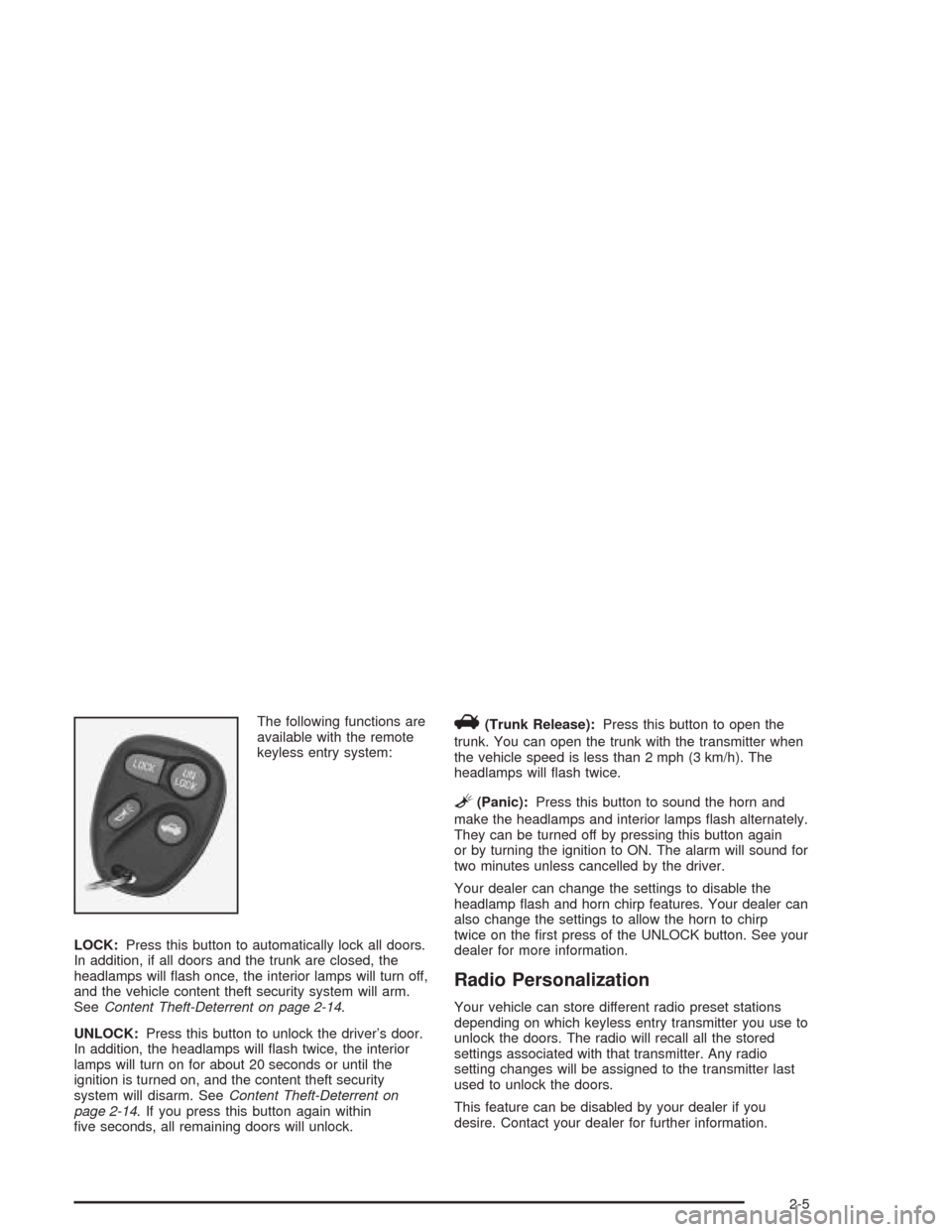
The following functions are
available with the remote
keyless entry system:
LOCK:Press this button to automatically lock all doors.
In addition, if all doors and the trunk are closed, the
headlamps will �ash once, the interior lamps will turn off,
and the vehicle content theft security system will arm.
SeeContent Theft-Deterrent on page 2-14.
UNLOCK:Press this button to unlock the driver’s door.
In addition, the headlamps will �ash twice, the interior
lamps will turn on for about 20 seconds or until the
ignition is turned on, and the content theft security
system will disarm. SeeContent Theft-Deterrent on
page 2-14. If you press this button again within
�ve seconds, all remaining doors will unlock.V(Trunk Release):Press this button to open the
trunk. You can open the trunk with the transmitter when
the vehicle speed is less than 2 mph (3 km/h). The
headlamps will �ash twice.
L(Panic):Press this button to sound the horn and
make the headlamps and interior lamps �ash alternately.
They can be turned off by pressing this button again
or by turning the ignition to ON. The alarm will sound for
two minutes unless cancelled by the driver.
Your dealer can change the settings to disable the
headlamp �ash and horn chirp features. Your dealer can
also change the settings to allow the horn to chirp
twice on the �rst press of the UNLOCK button. See your
dealer for more information.
Radio Personalization
Your vehicle can store different radio preset stations
depending on which keyless entry transmitter you use to
unlock the doors. The radio will recall all the stored
settings associated with that transmitter. Any radio
setting changes will be assigned to the transmitter last
used to unlock the doors.
This feature can be disabled by your dealer if you
desire. Contact your dealer for further information.
2-5
Page 71 of 354
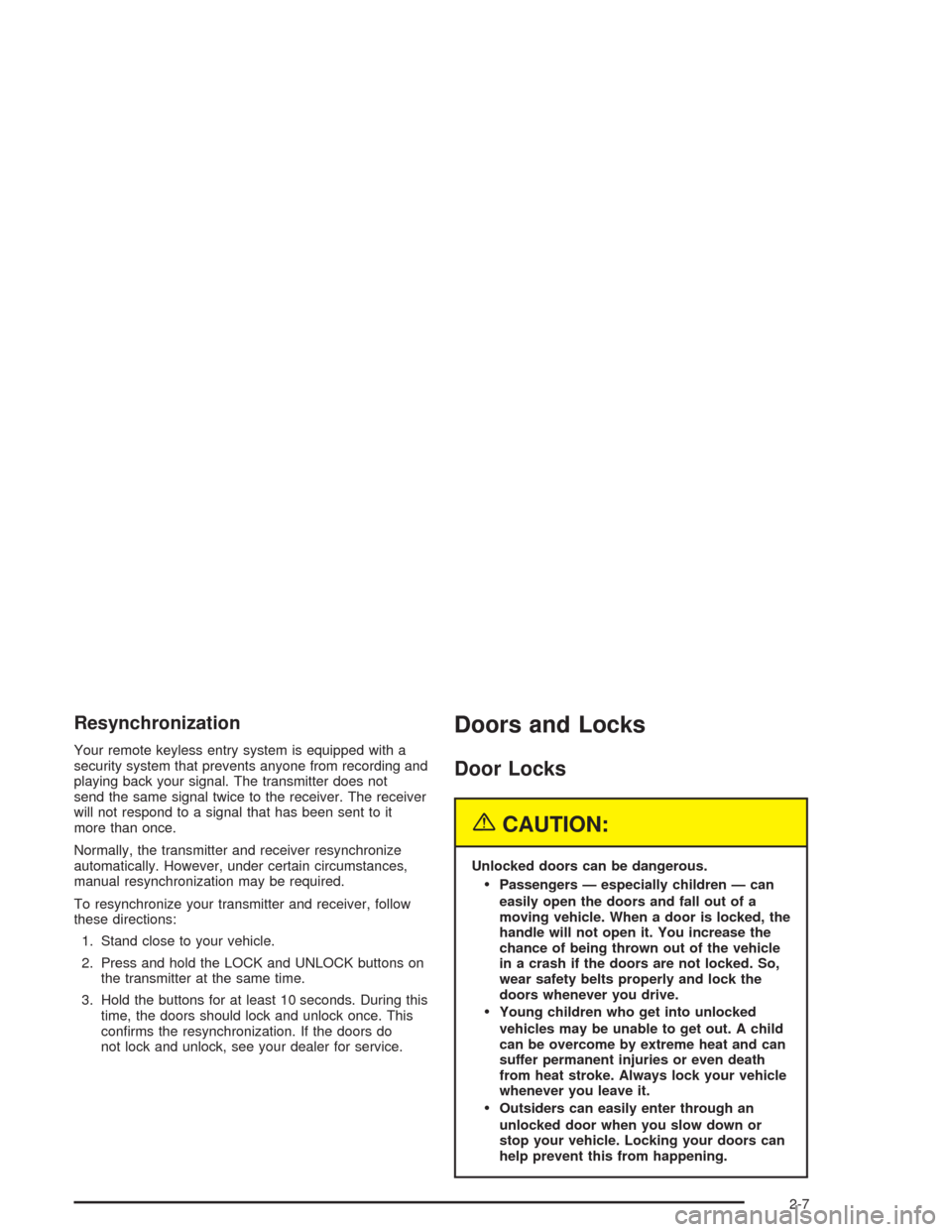
Resynchronization
Your remote keyless entry system is equipped with a
security system that prevents anyone from recording and
playing back your signal. The transmitter does not
send the same signal twice to the receiver. The receiver
will not respond to a signal that has been sent to it
more than once.
Normally, the transmitter and receiver resynchronize
automatically. However, under certain circumstances,
manual resynchronization may be required.
To resynchronize your transmitter and receiver, follow
these directions:
1. Stand close to your vehicle.
2. Press and hold the LOCK and UNLOCK buttons on
the transmitter at the same time.
3. Hold the buttons for at least 10 seconds. During this
time, the doors should lock and unlock once. This
con�rms the resynchronization. If the doors do
not lock and unlock, see your dealer for service.
Doors and Locks
Door Locks
{CAUTION:
Unlocked doors can be dangerous.
Passengers — especially children — can
easily open the doors and fall out of a
moving vehicle. When a door is locked, the
handle will not open it. You increase the
chance of being thrown out of the vehicle
in a crash if the doors are not locked. So,
wear safety belts properly and lock the
doors whenever you drive.
Young children who get into unlocked
vehicles may be unable to get out. A child
can be overcome by extreme heat and can
suffer permanent injuries or even death
from heat stroke. Always lock your vehicle
whenever you leave it.
Outsiders can easily enter through an
unlocked door when you slow down or
stop your vehicle. Locking your doors can
help prevent this from happening.
2-7